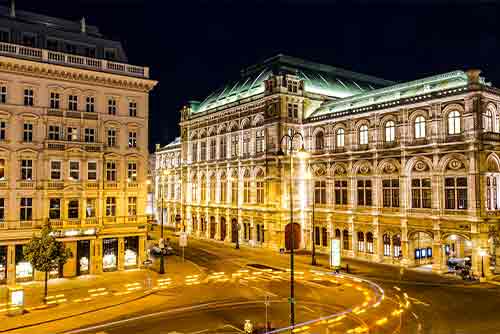5 Hotspots to reach by Vienna metro
Vienna, the capital of Austria, is one of Europe’s most beautiful cities. It’s known for its historical heritage and culture and is home to a rich arts and culture scene, including art, music, cuisine, and wine. Vienna is home to many beautiful parks and gardens, cathedrals, and palaces. Some of the top attractions include St. Stephen’s Cathedral, Hofburg Palace, and Belvedere Palace. Vienna’s efficient and convenient subway system makes it easy to visit many of these attractions.
Austria : Travel Information And Tips
Here are five attractions that can be reached by subway.
Vienna subway line map (U-bahn map)
Download the file below.
1. Stephansplatz
This beautiful square in the heart of Vinnena is home to St. Stephen’s Cathedral. The cathedral is a Gothic-style building, standing at around 137 meters high, and is Austria’s tallest Gothic cathedral, with its pointed towers visible from a distance and a very impressive roof. It is known as the symbol and landmark of Vinnena. St. Stephen’s Cathedral was the site of the wedding and funeral of the genius musician Mozart and was originally built in the mid-12th century in Romanesque style, but the Habsburgs added a Gothic addition in 1359, giving it its current appearance as a blend of the two architectural styles. It’s easily accessible on foot from the Stephanplatz station on the subway lines 1 and 3. The square is surrounded by shops, cafes, restaurants, and other commercial establishments for shopping and dining.
2. Vienna Opera
(Vienna Opera House)
The Vienna Opera is a world-renowned opera house located on Kärntner Straße. The theater presents high-quality music and theater performances and is also known for its architectural beauty. The Vienna State Opera House is said to be one of the top three opera houses in the world, along with the Paris Opera House and the Milan Opera House.
The best place to enjoy the night view of the Vienna State Opera is at the Albertina Museum. From the second floor of the Albertina Museum, you can see the opera house and capture a beautiful night view of the Vienna State Opera.
You can get there by getting off at Karlsplatz on subway lines 1 and 2 and walking a short distance. There are plenty of shops and cafes around the opera house, which attracts a lot of tourists.
3. Schönbrunn Palace
Schönbrunn Palace is the home of the Habsburgs, a royal family that has been a part of European history for hundreds of years. It’s a great place to admire the opulent interiors and artwork they enjoyed. It’s built in a colorful Baroque style. Inside the palace, you’ll find the Emperor and Empress’s rooms and a museum with lots to see. Schönbrunn Palace is stunning inside, but the outdoor gardens are what really make it memorable. Surrounding the palace is a park with large gardens and wonderful statues where you can take a walk or have a picnic. Just get off at Schönbrunn station on subway line 4 and take a short walk.
4. Heldenplatz.
This is the city’s main square, home to the Hofburg Palace, city hall, and a cluster of museums.
In German, Burg means fortified castle, and Hof means palace. Hofburg is a palace of the Habsburg royal family with a history of about 650 years. The Hofburg is a collection of different architectural styles, as successive monarchs added new buildings. Karl VI lived in the palace until the 18th century.
Heldenplatz is Vienna’s main square, built on the large open space left after the Hofburg was built. Helden means “heroic” in German, so Heldenplatz is also known as Heroes’ Square in English, and indeed, Austrian heroes stand in giant statues on Heldenplatz.
The Ring Strasse, a road built by Emperor Franz Josef, is what we would call a ring road, circling Vienna’s historic center, centered around Heldenplatz and Hofburg. The Ring Strasse is densely packed with medieval architecture and attractions, so it’s efficient to take a tram to make the rounds. Many things have happened at Heldenplatz, but it is most famous for Hitler’s speech on March 15, 1938, where he announced the annexation of Austria by Nazi Germany.
Many important events in Austria take place here, and it’s a great place to experience the history and culture of a country. Get off at Museumsquartier or Rathaus station on subway line 2 and take a short walk to reach the square.
Grab a cup of Viennese coffee at one of the historic cafes and immerse yourself in the flavors of Vienna. The original name for Viennese coffee is Einspännerr, which means “single-horse drawn carriage” in German. The name comes from the fact that coachmen, who had difficulty getting out of their carriages, used to drink coffee topped with whipped cream to replenish their energy while waiting for their masters. There are many cafes and restaurants around the square where you can rest and eat.
5. Belvedere Palace
Built in the 18th century as a summer palace, the beautiful Baroque Belvedere Palace is a favorite among tourists from all over the world, not only because of the palace itself and its beautiful gardens, but also because of the Belvedere Gallery, where you can see works by Gustav Klimt, Austria’s most famous golden painter, or the expressionist Egon Schiele.
Get off at Landstraße-Belvedere station on the R subway line and take a short walk to reach the front of the palace. The Belvedere Palace is a must-visit attraction in Vienna, where you can enjoy beautiful landscaping and art at the same time.



